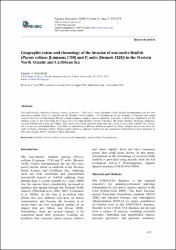/admin/item?itemID=6174b74e-0800-4f3c-9c94-24f8445e2849
Geographic extent and chronology of the invasion of non-native lionfish (Pterois volitans [Linnaeus 1758] and P. miles [Bennett 1828]) in the Western North Atlantic and Caribbean Sea

View/
Type of Access
OpenMaterial Type
ArticleType of Content
Scientific researchLanguage
EnglishCollection
- Investigación ambiental [1693]
Metadata
Show full item record| Abstract: | The Indo-Pacific lionfishes (Pterois volitans [Linnaeus 1758] and P. miles [Bennett 1828]: Family Scorpaenidae) are the first non-native marine fishes to establish in the Western North Atlantic. The chronology of the invasion is reported here using records from the US Geological Survey's Nonindigenous Aquatic Species database. Currently, lionfish are established off the Atlantic coast of the USA from the Florida Keys to Cape Hatteras (North Carolina), the Great Antilles, Bermuda, Bahamas, Cayman Islands and Turks and Caicos. The species have been reported from only one island in the Lesser Antilles (St. Croix), but it is not yet established there. Lionfish are established in Mexico, Honduras and Costa Rica. Reports have come from the Gulf of Mexico (Florida), Belize, Panama and Colombia; although lionfish are not considered established in these localities at this time (August 2009), invasion is likely imminent. |
| Author(s): | Schofield, Pamela J.
|
| Date: | 2009 |
| Published: | Aquatic Invasions, 4(3), 473-479 |
| Citation: | Schofield, P. J. (2009). Geographic extent and chronology of the invasion of non-native lionfish (Pterois volitans [Linnaeus 1758] and P. miles [Bennett 1828]) in the Western North Atlantic and Caribbean Sea. Aquatic Invasions, 4(3), 473-479. Recuperado de: |
| URI: | https://bvearmb.do/handle/123456789/3804
|

